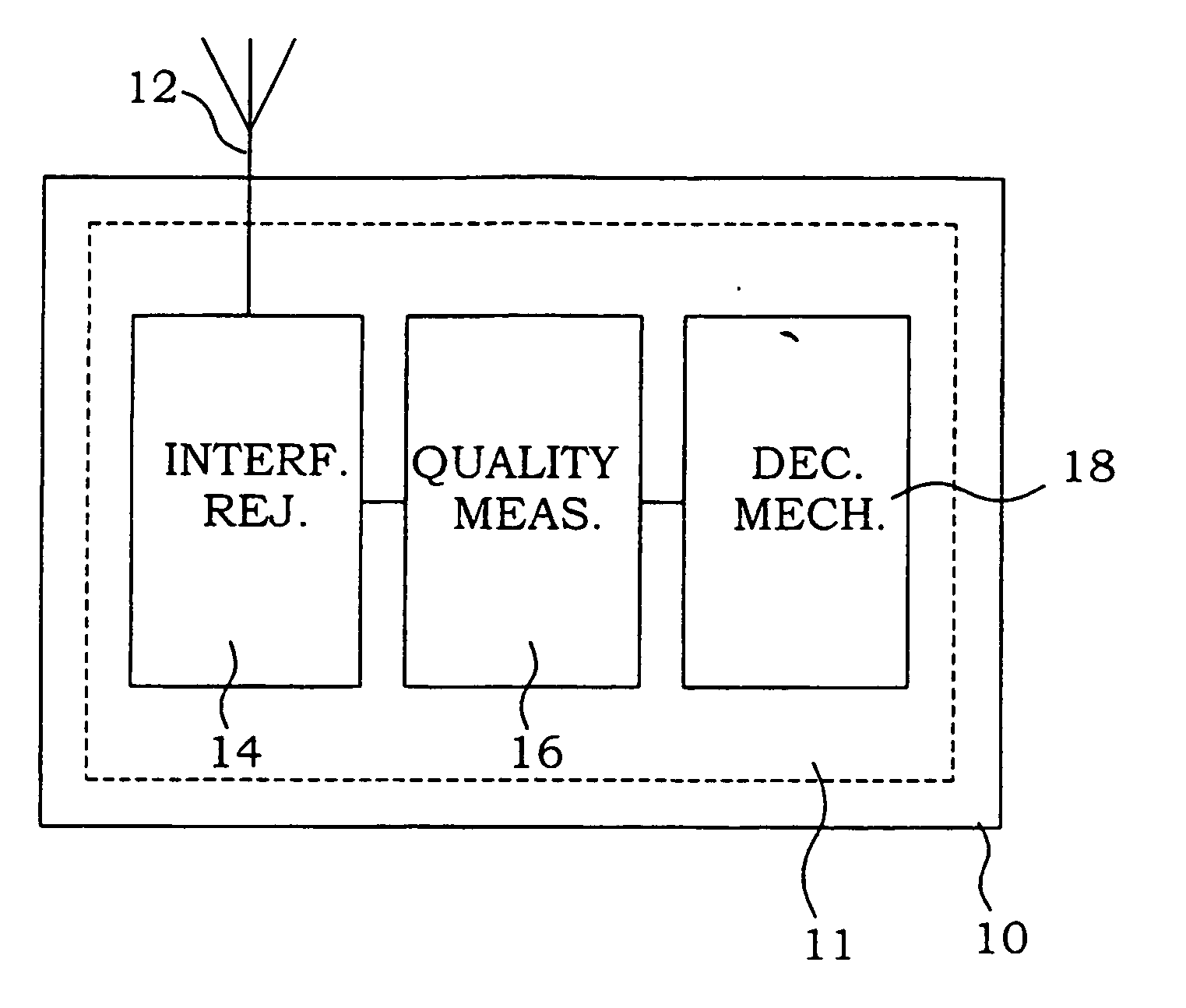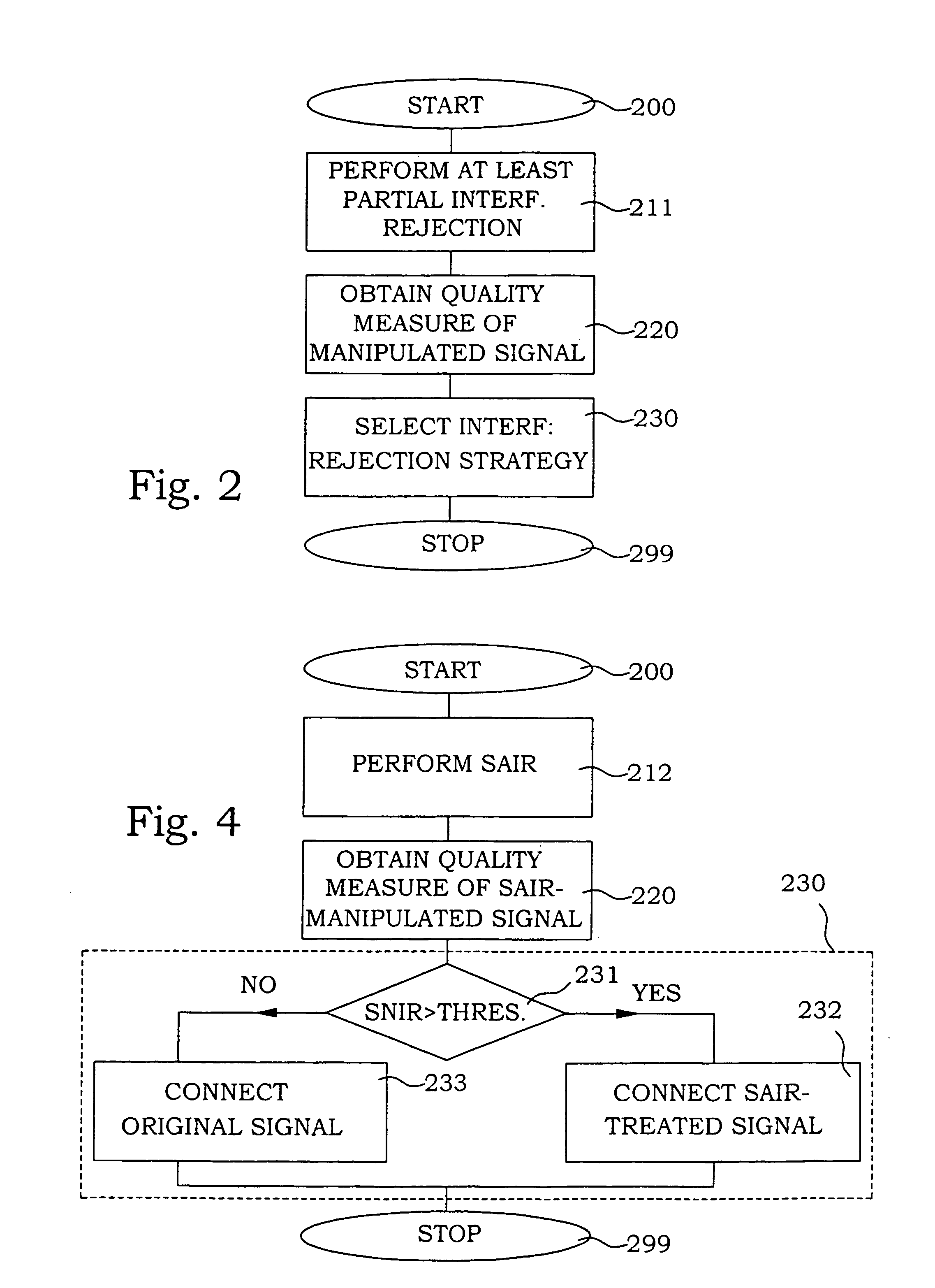Signal receiver devices and methods
a signal receiver and receiver technology, applied in the field of signal receiver devices and methods, can solve problems such as poor reception, interference rejection methods of prior art, and common consideration of multi-user detection techniques only, and achieve the effect of more robust interference rejection
- Summary
- Abstract
- Description
- Claims
- Application Information
AI Technical Summary
Benefits of technology
Problems solved by technology
Method used
Image
Examples
first embodiment
[0035] a receiver 10 according to the present invention is illustrated in FIG. 3. A signal is received in an interference rejection section 11 at a receiving interface 12. The signal is provided to a SAIR section 26, where a SAIR procedure is applied to the received signal. The manipulated signal is provided both to a quality measure detector 16 and a switch 22. The quality measure detector 16 is in this particular embodiment provided with means for estimating a ratio between the signal and the sum of noise and interference.
[0036] The quality measure of the manipulated signals is provided to a decision mechanism 18. In this embodiment, the decision mechanism simply compares the quality measures with a threshold value. If the quality measure is better than the threshold, it is assumed that the interference signal is of e.g. a GMSK type where SAIR is efficient. The decision mechanism 18 sends a control signal to the switch 22, for connection of the manipulated signal terminal accordin...
second embodiment
[0039] a receiver according to the present invention is illustrated in FIG. 5. It resembles the embodiment of FIG. 3 and similar parts are not discussed again. The essential difference is that also the originally received signal is provided to the quality measure detector 16. Subsequently, two quality measures are provided from the quality measure detector 16 to the decision mechanism 18. In the decision mechanism 18, the decision may now instead be based on e.g. the ratio between the quality measures. This means that if the original signal is essentially free from interference, the decision mechanism 18 may control the switch 22 to select the original signal. Any possible deterioration of the original signal is then avoided.
[0040] In the present embodiment, the receiver is furthermore arranged to let the decision mechanism 18 also control 25 the input 27 to the SAIR section 26. This design allows a first decision to be made entirely based on only the quality measure of the original...
third embodiment
[0042] A third embodiment is illustrated in FIG. 7. This embodiment is intended to be used in an EDGE system, where the receiver comprises means for handling GMSK modulation. In an EDGE system, signals of either GMSK- or 8PSK-modulation are present. Furthermore, a training sequence is sent in connection with the digital data. The position of this sequence as well as the content is well known. This fact is used in the present embodiment to reduce unnecessary process power utilization. Instead of performing the “preliminary” interference rejection on the entire signal, the interference rejection is only performed on the training sequence. Furthermore, in this embodiment, the quality measure detector 16 detects the residual error of the signal after channel estimation. (Channel estimation is performed also in connection with the interference rejection.)
[0043] In FIG. 7, the received signal is thus provided to a partial SAIR section 28, where SAIR is employed over only the training sequ...
PUM
 Login to View More
Login to View More Abstract
Description
Claims
Application Information
 Login to View More
Login to View More - R&D
- Intellectual Property
- Life Sciences
- Materials
- Tech Scout
- Unparalleled Data Quality
- Higher Quality Content
- 60% Fewer Hallucinations
Browse by: Latest US Patents, China's latest patents, Technical Efficacy Thesaurus, Application Domain, Technology Topic, Popular Technical Reports.
© 2025 PatSnap. All rights reserved.Legal|Privacy policy|Modern Slavery Act Transparency Statement|Sitemap|About US| Contact US: help@patsnap.com



